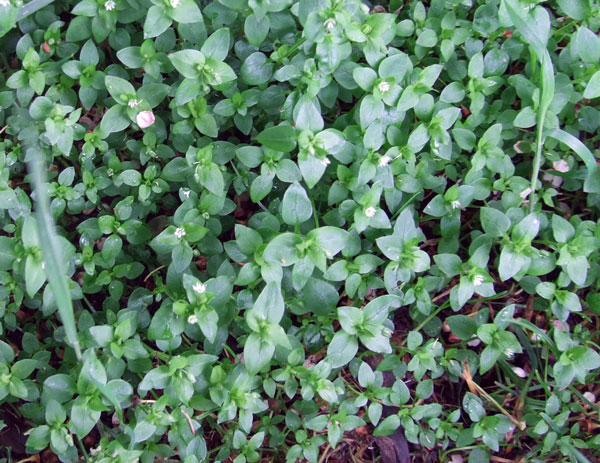 Botanical name: Stellaria media
Botanical name: Stellaria media
Family: Caryophyllaceae
Aliases: Chickenwort, winterweed
General information
Common chickweed is an annual or overwintering plant, it is one of the most common weeds in cultivated land. It is also common on roadside verges, waste areas and borders, especially where excessive shade occurs. It is less common in managed turf but is often found in newly seeded turf, as it competes with the new seedlings.
The weak straggly stems form in to low growing mat that typically grows to around 50mm in height, although it can grow higher. Reproduction is by seed and it can produce up to 5 generations of plants from a single seed. Common chickweed prefers moist soil conditions, as it has a shallow root system and can be removed fairly easily by hand weeding.
Common chickweed has a variety of health benefits, as it contains many vitamins and nutrients. It is frequently used in salads and has a taste similar to spinach.
Identification
- Leaf: The leaves are paired on the opposite sides of the stem, they are oval-heart shaped, with a smooth surface and can measure anywhere between 5-25mm in length. They are very similar in appearance to the leaves of scarlet pimpernel.
- Flower: The small whitish flowers are very similar to those of mouse-ear chickweed. Each flower has 5 lobes, but they so deeply cut that they give the appearance of 10 lobes. The flowering period between February and November, but it is not uncommon for common chickweed to flower all year round.
Common Chickweed Images (click image to enlarge)
More images and free downloads of Common Chickweed
Prevention and control
Hand weeding can be very effective, as this weed is shallow rooted and easily removed.
Encourage healthy turf with good turf care practices such as regular feeding, aeration, scarification etc.
Common chickweed is more common in newly sown areas than established areas, once regular mowing commences this weed should eventually disappear.
If for what ever reason this weed persists, chemicals can be used to eradicate it from turf. In most cases a single application should do the trick, as chickweed is very susceptible to most ingredients used in selective herbicides. If possible only treat the infected area and avoid the unnecessary use of chemicals.
Recommended products for the control of common chickweed
Professional products (The user requires the appropriate certificate/s to apply these products)
Headland Relay Turf (Mecoprop-p, Dicamba, MCPA)
Headland Cabadex (Fluroxypyr, Flurosulam)
React Ultra (Mecoprop-p, Dicamba, MCPA)
Everris Praxys (Clopyralid, Fluroxypyr, Fluosulam)
Bayer Longbow (Mecoprop-p, Dicamba, MCPA)
Barclay Holster XL (2,4-D, Fluroxypyr, Dicamba)
Mascot Greenor (Clopyralid, Fluroxypyr, MCPA)
Mascot Junction (2,4-D, Flurosulam)
Mascot Crossbar (2,4-D, Flurosulam, Dicamba)
Vitax Esteem (2,4-D, Clopyralid, MCPA)
Products available for non-professional use (These products are available from garden centres and DIY stores)
Verdone extra (Clopyralid, Fluroxypyr, MCPA)
Resolva lawn weed killer (2,4-D, Mecoprop-p, MCPA, Dicamba)
Doff lawn spot weeder (2,4-D, Mecoprop-p, Dichlorprop-p)
Vitax Lawn Clear (2,4-D, Clopyralid, MCPA)
Vitax Green up weed & feed (Dicamba, MCPA)
Weedol lawn weed killer (Clopyralid, Fluroxypyr, MCPA)
Scotts lawn builder weed & feed (2,4-D, Dicamba)




